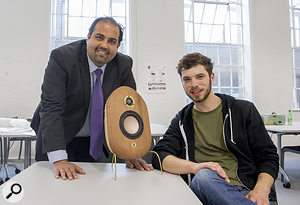 The housing for the FungiSound speaker was grown in a mould then baked to form a strong outer skin.
The housing for the FungiSound speaker was grown in a mould then baked to form a strong outer skin.
There are so many loudspeaker designs out there, it can sometimes seem like there isn’t mush room for new competition. However, a student from Nottingham Trent University in the UK has designed a new loudspeaker that has a housing made from the mycelium of oyster mushrooms. Bertie Ford, who created FungiSound as part of his BSc Product Design degree, says his project also sends out an environmental message about the imaginative use of natural materials.
Using mycelium — the subterranean fungal network from which mushrooms grow — the 22-year-old has made a speaker housing that boasts natural sound dampening properties. Bertie says his prototype combines sound quality with sustainability, unlike many other speakers in the market. While his claim about the sound has not been verified by anyone at SOS, his project is intriguing.
“Mycelium is the largest living organism on Earth, but few people realise its potential as a sustainable material,” said Bertie, who is studying in the School of Architecture, Design and the Built Environment. “Not only does it have comparable properties to materials such as medium-density fibreboard (MDF) it has good sound dampening qualities too.
 Fun guys: Design student Bertie Ford and supervisor Prof. Amin Al-Habaibeh.“As well as creating a new speaker, I hope to show a currently unconvinced market that organic materials can be used to create high-end consumer products with function and form.”
Fun guys: Design student Bertie Ford and supervisor Prof. Amin Al-Habaibeh.“As well as creating a new speaker, I hope to show a currently unconvinced market that organic materials can be used to create high-end consumer products with function and form.”
To create the product, mycelium for oyster mushrooms is grown into a mould and fed coffee waste and a straw mix — classified as agricultural waste — for around two to three weeks. When the growth fills the mould, it’s removed and cured in an oven on a low temperature for up to six hours. During this process the mycelium dies and a strong outer skin is created, with all moisture being removed.
As the product is intended to reach the high end of the market, the face of the speaker can be finished with a range of materials including brass and wood — so you don’t have to actually look at the baked fungus.
“My hope is that by showing people mycelium’s true potential, it will stimulate more green-thinking and open consumers’ minds to other organic materials and sustainability,” said Bertie, “Mycelium has the potential to be used beyond audio equipment as it has qualities which may be relevant to other industries; furniture and construction to name but two.”
The project was in collaboration with Espresso Mushroom Company, the industrial advisors on the project. If you want to check out the mushroom speakers for yourself, Bertie’s design will go on show at the 2017 Degree Show from 3 to 10 June at the university’s City Campus.
[Updated June 3rd: Mycelium is not the root of a mushroom. Mushrooms are the fruit of mycelium, a subterranean fungal organism.]
